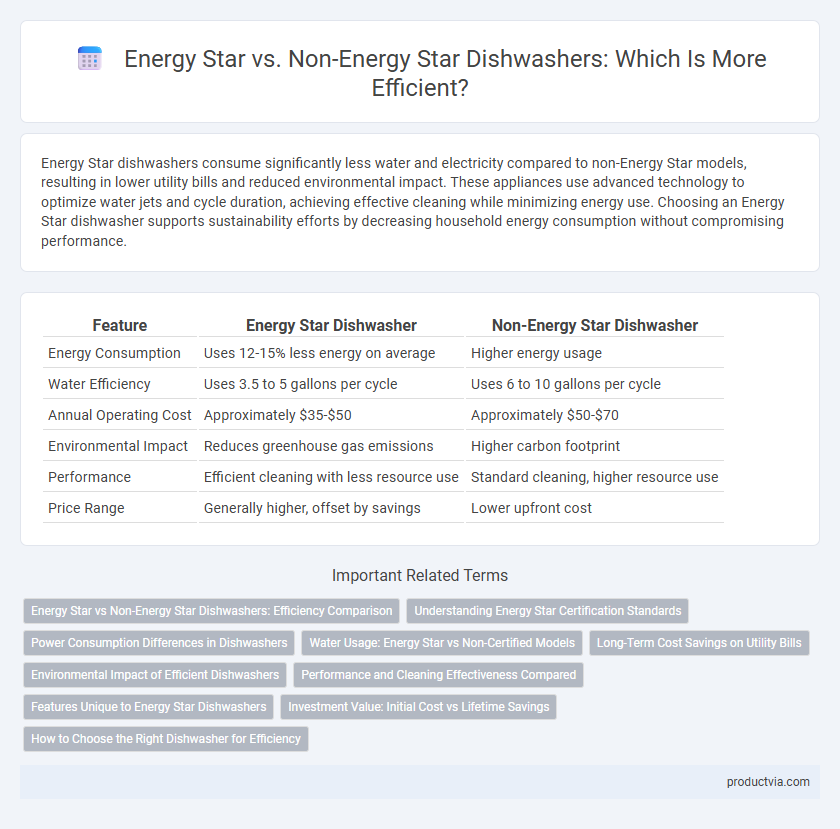Energy Star dishwashers consume significantly less water and electricity compared to non-Energy Star models, resulting in lower utility bills and reduced environmental impact. These appliances use advanced technology to optimize water jets and cycle duration, achieving effective cleaning while minimizing energy use. Choosing an Energy Star dishwasher supports sustainability efforts by decreasing household energy consumption without compromising performance.
Table of Comparison
| Feature | Energy Star Dishwasher | Non-Energy Star Dishwasher |
|---|---|---|
| Energy Consumption | Uses 12-15% less energy on average | Higher energy usage |
| Water Efficiency | Uses 3.5 to 5 gallons per cycle | Uses 6 to 10 gallons per cycle |
| Annual Operating Cost | Approximately $35-$50 | Approximately $50-$70 |
| Environmental Impact | Reduces greenhouse gas emissions | Higher carbon footprint |
| Performance | Efficient cleaning with less resource use | Standard cleaning, higher resource use |
| Price Range | Generally higher, offset by savings | Lower upfront cost |
Energy Star vs Non-Energy Star Dishwashers: Efficiency Comparison
Energy Star dishwashers consume approximately 12% less energy and 15% less water compared to non-Energy Star models, significantly reducing utility costs. These appliances incorporate advanced technology such as soil sensors and efficient motors to optimize water and electricity usage during wash cycles. Non-Energy Star dishwashers typically lack these features, resulting in higher environmental impact and increased operating expenses.
Understanding Energy Star Certification Standards
Energy Star certified dishwashers consume at least 12% less energy and 30% less water compared to non-Energy Star models, significantly reducing utility costs. These appliances meet strict environmental criteria set by the U.S. Environmental Protection Agency, ensuring superior performance and efficiency. Choosing an Energy Star dishwasher supports sustainable water usage and energy savings without compromising cleaning effectiveness.
Power Consumption Differences in Dishwashers
Energy Star dishwashers consume about 12-15% less electricity compared to non-Energy Star models, typically using around 270 kWh per year versus 310 kWh respectively. These efficiency gains result from advanced soil sensors, improved water jets, and better insulation, reducing overall power consumption. Consumers opting for Energy Star dishwashers benefit from lower utility bills and decreased environmental impact due to optimized energy usage.
Water Usage: Energy Star vs Non-Certified Models
Energy Star dishwashers use up to 3.5 gallons of water per cycle, significantly reducing consumption compared to non-certified models that often consume over 6 gallons. This efficient water usage lowers utility bills and supports sustainability efforts by minimizing water waste. Choosing an Energy Star dishwasher optimizes both environmental impact and operational cost through superior water efficiency.
Long-Term Cost Savings on Utility Bills
Energy Star dishwashers consume 10-15% less water and 20% less energy compared to Non-Energy Star models, leading to significant utility bill reductions over time. These efficient appliances can save an average of $35 annually on energy costs, accumulating substantial savings across the typical 10-year dishwasher lifespan. Investing in Energy Star certified dishwashers promotes both environmental sustainability and long-term financial benefits through lowered utility expenses.
Environmental Impact of Efficient Dishwashers
Energy Star dishwashers consume up to 12% less energy and 30% less water than non-Energy Star models, significantly reducing greenhouse gas emissions associated with electricity and water usage. Efficient dishwashers lower household carbon footprints by minimizing energy demand from power plants, many of which rely on fossil fuels. Choosing Energy Star-certified appliances supports sustainable resource use and helps decrease overall environmental pollution.
Performance and Cleaning Effectiveness Compared
Energy Star dishwashers consistently outperform non-Energy Star models in both energy efficiency and cleaning effectiveness, using advanced soil sensors and targeted spray arms to optimize water and detergent use. These models typically achieve superior stain removal and drying performance while consuming up to 12% less energy and 15% less water annually. High-efficiency motors and precise cycle adjustments ensure thorough cleaning results, making Energy Star dishwashers a cost-effective and environmentally friendly choice.
Features Unique to Energy Star Dishwashers
Energy Star dishwashers incorporate advanced soil sensors and precision wash cycles that optimize water and energy use, significantly reducing consumption compared to non-Energy Star models. Unique features such as eco-wash modes and improved insulation enhance energy efficiency without compromising cleaning performance. These innovations result in lower utility bills and decreased environmental impact, making Energy Star dishwashers a superior choice for sustainable home appliances.
Investment Value: Initial Cost vs Lifetime Savings
Energy Star dishwashers typically have higher initial costs but offer significant lifetime energy and water savings, reducing utility bills by up to 30%. Non-Energy Star models may cost less upfront but often incur greater operational expenses, leading to higher total ownership costs over time. Investing in Energy Star appliances enhances long-term value through improved efficiency and potential rebates, making them more cost-effective despite the premium price.
How to Choose the Right Dishwasher for Efficiency
Energy Star dishwashers consume at least 12% less energy and 30% less water compared to non-Energy Star models, making them more efficient and cost-effective over time. When choosing the right dishwasher for efficiency, prioritize units with Energy Star certification, high soil sensors, and adjustable racks to optimize water and energy use. Compare EnergyGuide labels to assess estimated annual energy consumption and operating costs before making a purchase.
Energy Star vs Non-Energy Star for Efficiency Infographic

 productvia.com
productvia.com